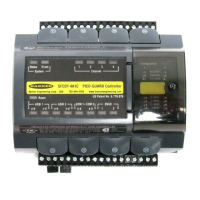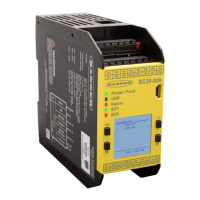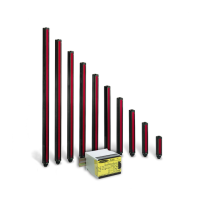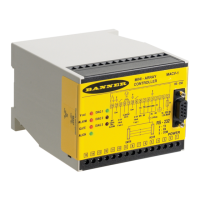12 P/N 69761 rev. B
Banner Engineering Corp. • Minneapolis, U.S.A.
www.bannerengineering.com • Tel: 763.544.3164
PICO-GUARD Controller
Instruction Manual
3.9.2 MPCE and FSD Interfacing Connections
Each of the two machine primary control elements (MPCE1
and MPCE2) must be capable of immediately stopping the
dangerous machine motion, irrespective of the state of the
other. These two machine control channels need not be
identical, but the stop time performance of the machine (Ts,
used to calculate the separation distance; see PICO-GUARD
Application and Design Guide, p/n 69763) must take into
account the slower of the two channels. Some machines offer
only one primary control element. For such machines, it is
necessary to duplicate the circuit of the single MPCE to add a
second. Refer to Figures 3-8 and 3-9 or consult the machine
manufacturer for additional information.
Final Switching Devices (FSDs) can take many forms, though
the most common are forced-guided, mechanically linked
relays or interface modules. The mechanical linkage between
the contacts allows the device to be monitored by the external
device monitoring (EDM) circuit for certain failures.
Depending on the application, the use of FSDs can facilitate
controlling voltage and current that differs from the OSSD
outputs of the PICO-GUARD. FSDs can also be used to control
an additional number of hazards by creating multiple safety
stop circuits.
3.8.2 Optical Element Alignment
Align all optical elements of each optical channel, per the
instructions for the individual devices (see the appropriate
device instruction manuals and the PICO-GUARD Application
and Design Guide).
3.8.3 Verify System Operation
Perform the Trip Test. The procedure for the Trip Test is
dependent on the types of optical element(s) used. Refer to the
appropriate Daily Checkout procedure(s) for Trip Testing the
optical element(s) used in your application.
Do not continue operation until the entire checkout
procedure is completed and all problems are corrected.
3.9 Electrical Interface to the Guarded Machine
(Permanent Hookup)
Make the electrical connections as described in Sections 3.9.1
to 3.9.5 as required by each individual application.
System power and the System Reset switch should already be
connected by this point. The PICO-GUARD system must also
have been aligned and passed the Initial System Checkout, as
described in Section 3.8. The final connections to be made are:
• OSSD outputs
• FSD interfacing
• MPCE/EDM connections
3.9.1 OSSD Output Connections
Both Output Signal Switching Device (OSSD) outputs must
be connected to the machine control so that the machine’s
safety-related control system interrupts the circuit or power to
the Machine Primary Control Element(s) (MPCE), resulting in a
non-hazardous condition.
Final Switching Devices (FSDs) typically accomplish this when
the OSSDs go to an OFF state. See Figure 3-7.
Refer to the output specifications in Section 2.7 and the
following Warnings before making OSSD output connections
and interfacing the PICO-GUARD System to the machine.
WARNING . . . Interfacing of Both OSSDs
Both of the OSSD (Output Signal Switching
Device) outputs must be connected to the
machine control so that the machine’s safety-
related control system interrupts the circuit to the machine
primary control element(s), resulting in a non-hazardous
condition.
Never wire any intermediate device(s) in such a manner that
the safety function can be suspended, overridden, or defeated,
unless accomplished in a manner at the same or greater
degree of safety.
WARNING . . . OSSD Interfacing
To ensure proper operation, the PICO-GUARD
OSSD output specifications and machine
input parameters must be considered when
interfacing the PICO-GUARD solid-state OSSD outputs to
machine inputs (see Section 2.7).
Machine control circuitry must be designed so that the
maximum load resistance value is not exceeded and so that the
maximum specified OSSD OFF-state voltage does not result in
an ON condition.
Failure to properly interface the OSSD outputs to the guarded
machine could result in serious bodily injury or death.
Installation and Alignment

